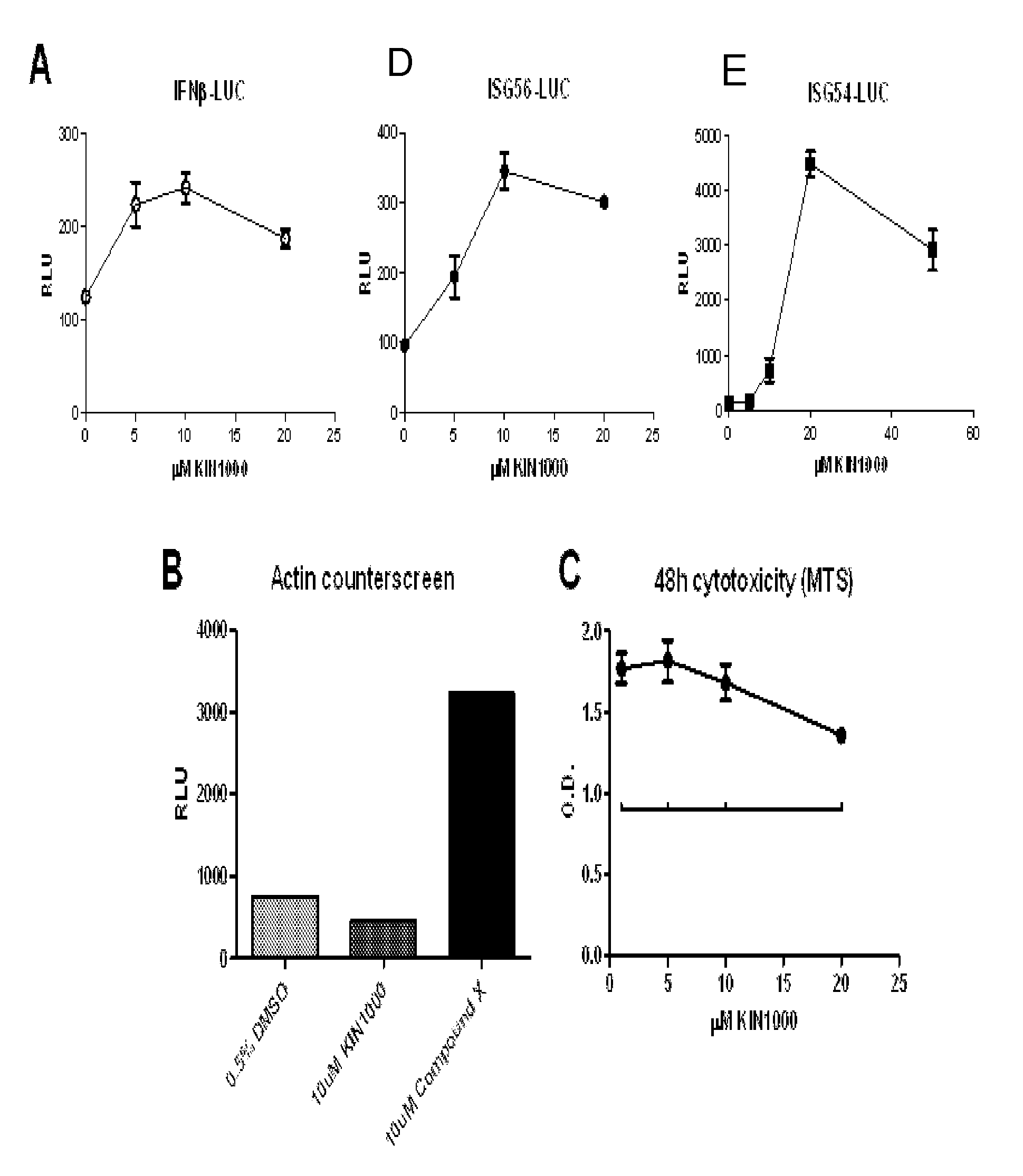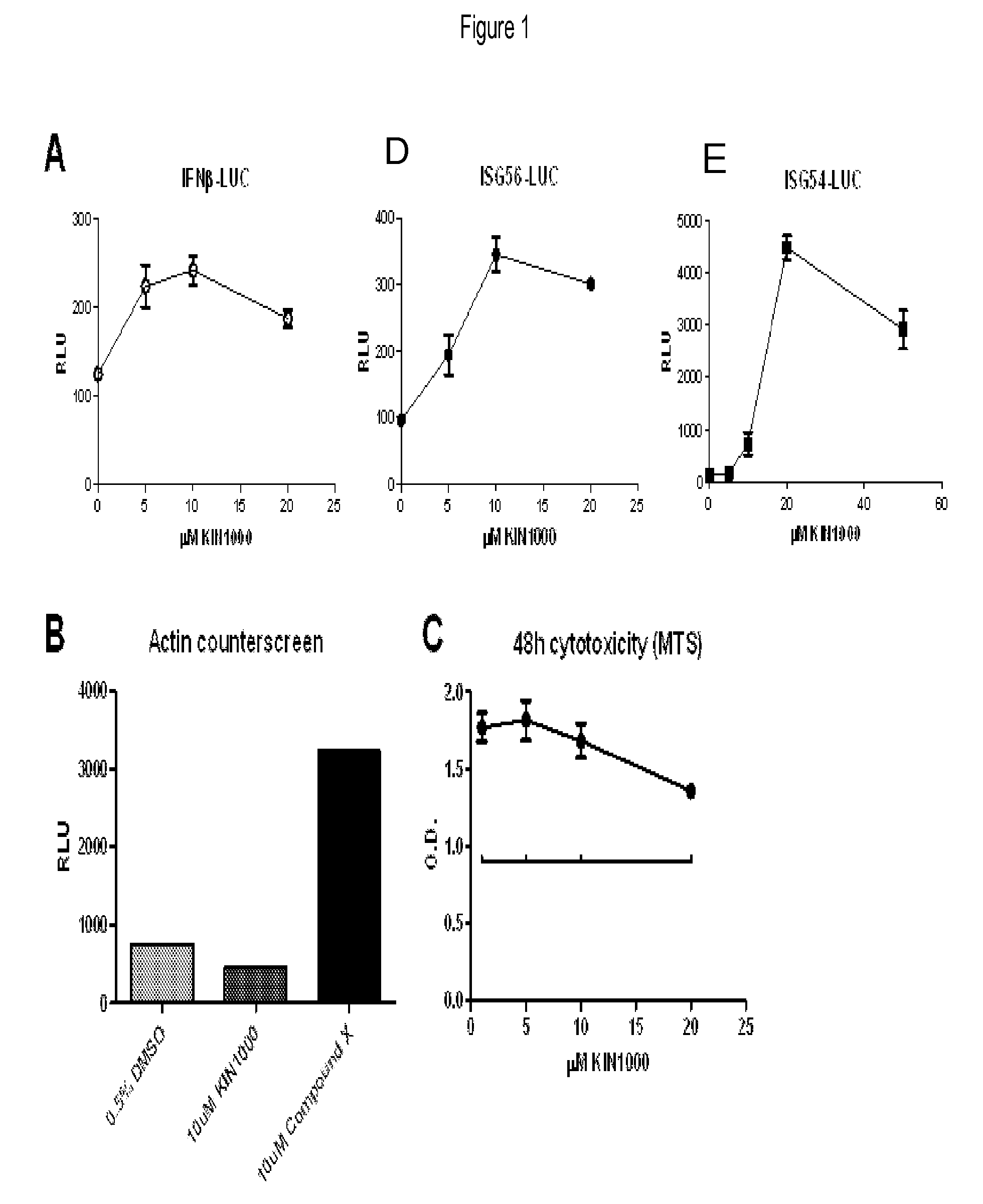Anti-viral compounds
a technology of compounds and antivirals, applied in the field of antiviral compounds, can solve the problems of limited antiviral drugs, large public health problems of rna viruses, and many poorly effective drugs, and achieve the effects of reducing side effects, less susceptible, and enhancing the host's innate antiviral respons
- Summary
- Abstract
- Description
- Claims
- Application Information
AI Technical Summary
Benefits of technology
Problems solved by technology
Method used
Image
Examples
example 1
Biological Activity of KIN1000
[0233]Luciferase Assay to Identify Active Compounds.
[0234]Cultured human cells that were stably transfected with a luciferase reporter gene coupled with a RIG-I signaling pathway responsive promoter (IFNβ, ISG56, or ISG54 promoter) were seeded and allowed to grow overnight. The compound “KIN1000” was then added and cells were grown in the presence of KIN1000 for 18-20 hours. Steady-Glo luciferase substrate (Promega) was added and luminescence was read on a luminometer (Berthold).
[0235]FIG. 1A shows that KIN1000 as described herein was validated by demonstrating dose-dependent induction of the luciferase reporter gene coupled to the promoters for IFNβ (“IFNβ-LUC,” left), ISG56 (“ISG56-LUC,” center), and ISG54 (“ISG54-LUC,” right). Additionally, KIN1000 did not induce a nonspecific promoter (β-actin-LUC, FIG. 1B).
[0236]MTS Assay to Determine Cytotoxicity.
[0237]Cultured human HeLa cells were treated with increasing amounts of compound or equivalent amounts...
example 2
Antiviral Activity of KIN1000 Against Influenza WSN Strain
[0245]MRC5 cells were treated with increasing amounts of KIN1000 12-24 hours prior to infection by influenza virus. The number of infected cells 24 hours after introduction of virus was then quantified by an immunofluorescent assay of viral protein in cells. The KIN1000 compound disclosed herein demonstrated efficient activity against influenza virus strain WSN. FIG. 3 shows that MRC5 cells treated with increasing amounts of KIN1000 showed a dose-dependent decrease in infection by influenza virus.
example 3
Ex Vivo Immune Stimulatory Activity of KIN1000
[0246]The activity of KIN1000 in primary immune cells was assayed to determine whether KIN1000 stimulates immune responses. Cultured human primary dendritic cells were treated with 0, 1, or 10 μM of KIN1000 for 24 hours. Supernatant from treated wells was isolated and tested for levels of cytokine protein. Cytokines were detected using specific antibodies conjugated to magnetic beads and a secondary antibody that reacts with Streptavidin / Phycoerythrin to produce a fluorescent signal. The bound beads were detected and quantified using the Magpix® (Luminex Corp., Austin, Tex.) instrument, although similar techniques as are known in the art may be used to measure fluorescent protein production, such as for example an ELISA.
[0247]KIN1000 was shown to induce expression of the chemokines IL-8, MCP-1, MIP-1α and MIP-1β by dendritic cells (FIG. 4).
[0248]Other cells from which cytokine secretion can be measured include, for example but without li...
PUM
| Property | Measurement | Unit |
|---|---|---|
| volume | aaaaa | aaaaa |
| time | aaaaa | aaaaa |
| pharmaceutical composition | aaaaa | aaaaa |
Abstract
Description
Claims
Application Information
 Login to View More
Login to View More - R&D
- Intellectual Property
- Life Sciences
- Materials
- Tech Scout
- Unparalleled Data Quality
- Higher Quality Content
- 60% Fewer Hallucinations
Browse by: Latest US Patents, China's latest patents, Technical Efficacy Thesaurus, Application Domain, Technology Topic, Popular Technical Reports.
© 2025 PatSnap. All rights reserved.Legal|Privacy policy|Modern Slavery Act Transparency Statement|Sitemap|About US| Contact US: help@patsnap.com



